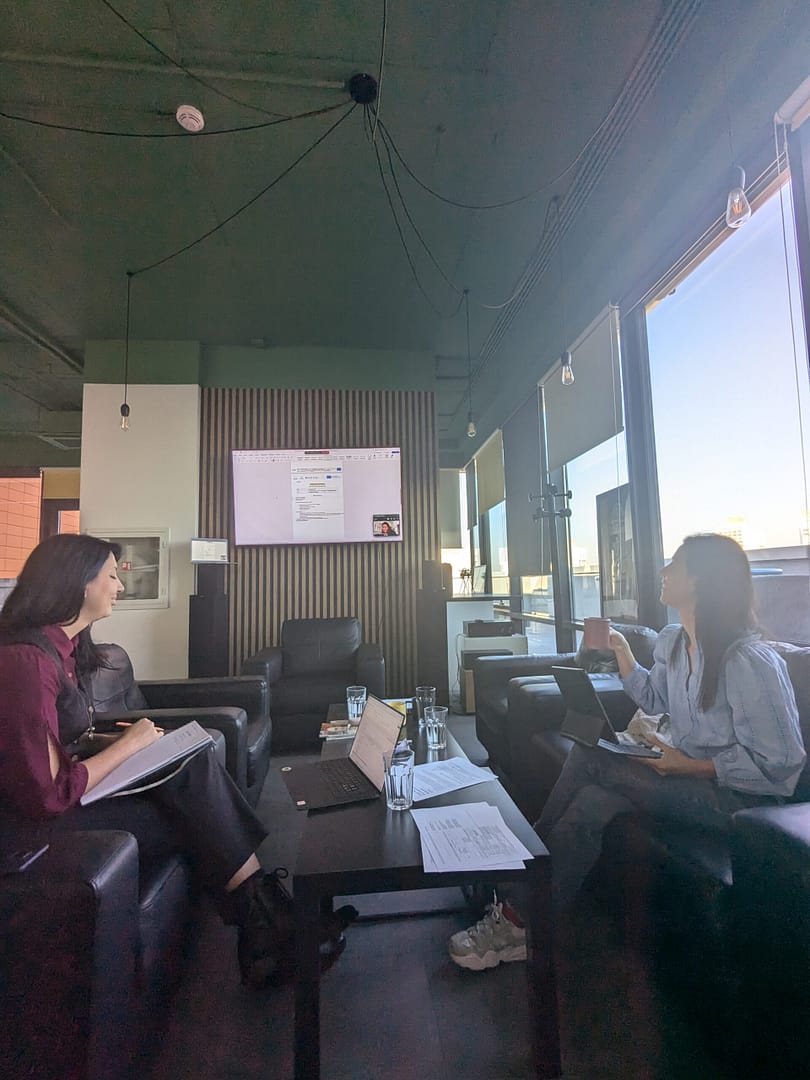Learning Outcomes:
- By the end of the session, participants should have a solid understanding of the co-design process and practical experience in co-designing the Green Changemakers Handbook that promotes green education among youth.
Duration:
2 hours and 30 minutes
Materials needed:
Laptop or computer
Projector and screen
- PPT Presentation
Whiteboard and markers
Flip charts and markers
Post-it notes
Pens and notebooks for participants
Printed handouts of the co-design process stages and methodologies
Evaluation forms for feedback
Preparation
- Prepare a PowerPoint presentation covering the session’s objectives, co-design fundamentals, process stages, methodologies, and tools.
- Print handouts of the presentation slides and additional materials.
- Arrange the room to facilitate group work and discussions.
- Gather all necessary materials (listed above).
- Create a simple practical project scenario focused on green education for youth.
- Prepare evaluation forms for participants to complete at the end of the session.
Description
Introduction and Objectives (5 minutes)
Welcome participants and introduce them to the second activity.
Explain the objectives and the structure of the activity.
Briefly discuss the importance of co-design and its application in developing NFE activities for green education.
Overview of Co-design in NFE activities (20 minutes)
Highlight the benefits of using a co-design approach, particularly in developing NFE activities:
- Increased Relevance and Effectiveness of Educational Activities:
- ask participants to share personal experiences where they felt an educational activity was particularly relevant or effective.
- Use group discussions to identify key factors that contributed to this relevance and brainstorm how co-design could enhance these elements in NFE activities.
- Enhanced Engagement and Ownership Among Participants:
- Conduct a brainstorming session where participants identify ways they can take ownership of educational activities.
- Facilitate a discussion on how co-design empowers them and increases their commitment to the outcomes.
- Development of Innovative and Context-Specific Solutions:
- Organize small group activities where participants identify unique challenges within their context and collaboratively brainstorm innovative solutions.
- Use case studies to illustrate how co-design has led to creative solutions in similar scenarios.
Discuss real-world examples of successful co-design projects:
- A Youth-Led Environmental Initiative Creating Community Garden Projects:
- Invite participants to brainstorm and share any youth-led environmental projects they know of.
- Discuss how these initiatives were developed and what role co-design might have played.
- Encourage participants to research similar projects and present their findings, highlighting the impact of co-design.
- A School Program Developing Sustainability Workshops Through Student-Teacher Collaboration:
- Ask participants to form small groups and brainstorm examples of school programs that focus on sustainability.
- Encourage them to explore online resources or their networks to find real-world examples.
- Have each group present their chosen program, explaining why they think co-design was integral to its success and how it could be applied to other contexts.
Demonstrating Co-Design Tools with NFE and Green Education Examples
- Example Brainstorming Technique:
- Using Mind Maps to Explore Environmental Debate Topics:
- Divide participants into small groups and provide each with a large sheet of paper or a digital whiteboard tool like Miro.
- Write “Environmental Debate Topics” in the center.
- Ask participants to brainstorm and add branches for different debate topics (e.g., renewable energy, plastic pollution, climate change policy).
- Have each group expand on these topics with sub-branches, including specific issues, potential arguments, and relevant facts.
- Using Mind Maps to Explore Environmental Debate Topics:
- Example Persona:
- Developing a Profile for a Typical Youth Participant:
- Ask participants to brainstorm attributes of a typical youth participant in green education.
- Use a template with categories like demographics, interests, motivations, and challenges. Provide templates and have each group develop a detailed persona. For example, “Alex, 16, passionate about marine biology, motivated by a desire to reduce ocean pollution, struggles with public speaking.”
- Have participants role-play as their created personas, discussing how these personas might interact with green education activities and what their needs and preferences would be.
- Developing a Profile for a Typical Youth Participant:
- Example Storyboard:
- Creating a Visual Representation of a Youth Participant’s Experience in a Debate Session:
- Ask participants to imagine a youth participant preparing for, participating in, and reflecting on an environmental debate session.
- Provide storyboard templates and drawing materials or digital tools like Canva. Each group creates a storyboard illustrating the key moments of the experience, such as research and preparation, the debate itself, and post-debate reflection.
- Have each group create a narrative around their storyboard, explaining the participant’s journey, challenges, and learning moments.
- Creating a Visual Representation of a Youth Participant’s Experience in a Debate Session:
Break (15 minutes)
Provide refreshments and encourage informal networking among participants.
Practical Exercise Introduction (10 minutes)
- Present the practical project scenario: “Eco-Voices: Co-Designing the Green Changemakers Handbook”
- Explain the objectives and expected outcomes of the exercise:
- Participants will start co-designing the Green Changemakers Handbook, aimed at promoting green education and empowering youth to become environmental advocates. The final handbook will include:
- a “Green Changemakers Social Campaign Kit”;
- Participants will start co-designing the Green Changemakers Handbook, aimed at promoting green education and empowering youth to become environmental advocates. The final handbook will include:
- NFE activities on green education;
- a short guide on how to be a Green Changemaker.
- Co-creation of the Green Changemakers Social Campaign Kit includes the development of campaign aim, visual identity or call to actions, as well as templates and tools for organizing community campaigns focused on sustainability.
- Co-creation of NFE Activities on Green Education includes the development of workshops, based on non-formal education methods, on topics like waste reduction, sustainable living, and biodiversity conservation.
- Co-creation of the Guide on How to Be a Green Changemaker includes the development of contributions to the Guide, with tips and strategies for young people to initiate and lead environmental projects and movements.
Practical Exercise (45 minutes)
- Divide Participants into Small Groups:
- Ensure diversity in each group to bring various perspectives to the discussion.
- Divide participants in small groups (3-4 participants). Each group will work on the main topic and a secondary topic.
- Main topic:
- Designing an NFE Activity on Green Education
- This will be the primary focus for all groups. Co-designing Non-Formal Education (NFE) activities will ensure that everyone contributes to developing creative and impactful learning experiences. These activities will be aimed at fostering an understanding of environmental issues and inspiring proactive involvement in sustainable practices.
- Designing an NFE Activity on Green Education
- Secondary topics:
- Developing the Social Campaign Kit
- This element of the initiative will focus on creating resources and tools that can be used to promote green education and sustainable practices through various social channels. Each group will be tasked with developing innovative and engaging content that can be used to raise awareness and inspire action among diverse audiences.
- Creating the Guide on How to Be a Green Changemaker
- Groups will collaborate on creating a comprehensive guide. This guide will offer practical tips and strategies for individuals who wish to become advocates for green living and sustainable development.
- Developing the Social Campaign Kit
- Once each group has chosen the secondary topic, participants can start working.If possible, make sure that groups are balanced when choosing the secondary topics.
- The trainer will guide the group work and start by suggesting to conduct a brainstorming session to generate ideas for the assignment.
- The trainer will remind groups use the discussed methodologies (Workshops, Focus Groups, User Journey Mapping) to refine their ideas.
- Workshops: Conduct mini-workshops within the group to generate solutions.
- Focus Groups: Simulate focus group discussions to explore deeper insights.
- User Journey Mapping: Create visual maps to outline the user experience for their feature.
- Each group will prepare a presentation to showcase their work on the main topic as well as the selected secondary topic. For the presentation they can get as creative as they want.
Group Presentations (30 minutes)
Each group give its presentation, showcasing their understanding of co-design in NFE activities and the practical application of their ideas to the Changemakers Handbook.
After each presentation, the trainer will facilitate a discussion, allowing other participants to provide feedback and suggestions.
Wrap-Up and Evaluation (15 minutes)
Summarise key takeaways from the session.
Distribute evaluation forms and collect feedback.
Encourage participants to share their thoughts and ask questions.
Thank participants for their engagement and participation.
Debriefing
Post-Activity Reflection
Following the practical exercise, give participants a moment to relax and mentally shift from active work to reflection. Encourage them to think about the process their group followed during the exercise and their personal contributions to the co-design process.
Facilitated Discussion
Lead a debriefing session with the following questions:
- Experience: What was the most challenging aspect of the co-design process your group experienced? How did your group navigate these challenges?
- Self-Insight: What did you learn about your collaborative skills and ability to contribute to a group co-design effort? Were there moments where you stepped up as a leader or where you struggled?
- Content Insight: What did you discover about the co-design process as it applies to creating NFE activities on green education? Did the stages of Research, Ideation, Prototyping, and Testing align with your expectations?
- Application: How can you apply the co-design process in developing future educational programs, especially in the context of sustainability and green education? What improvements would you suggest for future co-design projects?
Feedback and Evaluation (Optional)
At the end of the session, distribute evaluation forms that ask participants to rate their experience with the practical exercise. Include questions on the relevance of the co-design tools to the task and their perceived effectiveness of the process. Also, observe the presentations and group dynamics to assess how well participants grasped the co-design stages.
Actionable Outcomes
Conclude the debriefing by reviewing the insights gained during the exercise. Highlight how these insights can be utilized in real-world scenarios, particularly in designing educational initiatives focused on green education. Encourage participants to consider how they can refine their approach to co-design in future projects.
Tips
Introduction and Objectives (5 minutes):
Anchor It in Purpose: Start by explaining the real-world impact this co-design session could have. Emphasize that the Green Changemakers Handbook isn’t just a hypothetical exercise—it’s a tool that could inspire real action among youth for sustainable living. This gives participants a sense of purpose and responsibility.
Connect to Their Experience: Ask participants to think about a time they were part of an environmental campaign or project. What worked? What didn’t? This primes them to think critically about the challenges they’ll face in the co-design process.
Overview of Co-Design in NFE (20 minutes):
Make It Relevant: When discussing the benefits of co-design in non-formal education (NFE), relate it to real educational challenges participants might face, such as disengaged youth or outdated educational materials. Ask them to reflect on how co-design can solve these issues by giving participants ownership over the learning process.
Highlight Success Stories: Showcase examples of NFE programs that successfully used co-design, such as youth-led environmental initiatives that increased community engagement. Make sure to discuss how co-design empowered the participants and led to more creative and relevant educational outcomes.
Methodologies and Tools (15 minutes):
Turn Tools into Experiences: When demonstrating co-design tools like user journey mapping and brainstorming techniques, have participants walk through the tools as if they are the target audience. Ask them to map out not just what participants do, but how they feel at each stage of a journey in an environmental education program. This emotional connection makes the tools feel more tangible and useful.
Practical Exercise (45 minutes):
Challenge the Groups: When participants start working on the Green Changemakers Handbook, push them to create something truly unique. Ask them, “How will this handbook stand out from others on green education?” and “What will make this handbook feel personal and relevant to young people today?”
Foster Collaboration: Encourage each group to engage in mini-focus groups within their own team, where they critically assess each idea presented. This not only improves the ideas but also builds team dynamics where everyone feels heard.
Group Presentations (30 minutes):
Facilitate Constructive Criticism: After each presentation, encourage the other groups to provide constructive feedback, focusing on practical improvements rather than general praise. Ask questions like, “How could this be adapted for different educational settings?” or “How can you make this guide more accessible to a diverse range of young people?”
Wrap-Up and Evaluation (15 minutes):
End with Action: As you close, ask participants to commit to one small action they will take in their own professional or personal lives based on what they learned in the co-design process. This could be as simple as integrating more participatory methods into their projects or starting their own green education initiatives
Handouts and resources
Co-Design and NFE PPT
Co-design and NFE Handout
Evaluation form Co-design Handout
Guidelines for Handbook
A guide to Co-design
The trainer(s) can use these handouts for the session or create their own, as long as the same basic concepts are included (co-design).
More To Explore
Co-Design Processes and Methodologies
Learning Objectives (LOs)
Mentoring methodologies and strategies
Learning Objectives (LOs)


